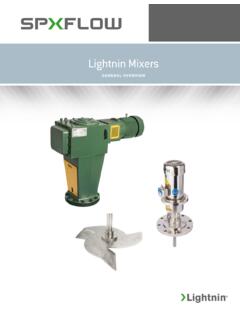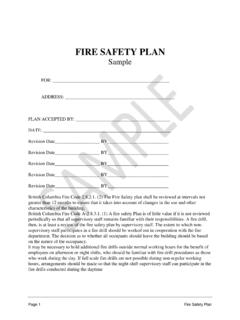Transcription of 1.4 Natural Gas Combustion - United States Environmental ...
1 Natural Gas Combustion General1-2 Natural gas is one of the major Combustion fuels used throughout the country. It is mainly used to generate industrial and utility electric power, produce industrial process steam and heat, and heat residential and commercial space. Natural gas consists of a high percentage of methane (generally above 85 percent) and varying amounts of ethane, propane, butane, and inerts (typically nitrogen, carbon dioxide, and helium). The average gross heating value of Natural gas is approximately 1,020 British thermal units per standard cubic foot (Btu/scf), usually varying from 950 to 1,050 Btu/scf.
2 Firing Practices3-5 There are three major types of boilers used for Natural gas Combustion in commercial, industrial, and utility applications: watertube, firetube, and cast iron. Watertube boilers are designed to pass water through the inside of heat transfer tubes while the outside of the tubes is heated by direct contact with the hot Combustion gases and through radiant heat transfer. The watertube design is the most common in utility and large industrial boilers. Watertube boilers are used for a variety of applications, ranging from providing large amounts of process steam, to providing hot water or steam for space heating, to generating high-temperature, high-pressure steam for producing electricity.
3 Furthermore, watertube boilers can be distinguished either as field erected units or packaged units. Field erected boilers are boilers that are constructed on site and comprise the larger sized watertube boilers. Generally, boilers with heat input levels greater than 100 MMBtu/hr, are field erected. Field erected units usually have multiple burners and, given the customized nature of their construction, also have greater operational flexibility and NOx control options. Field erected units can also be further categorized as wall-fired or tangential-fired. Wall-fired units are characterized by multiple individual burners located on a single wall or on opposing walls of the furnace while tangential units have several rows of air and fuel nozzles located in each of the four corners of the boiler.
4 Package units are constructed off-site and shipped to the location where they are needed. While the heat input levels of packaged units may range up to 250 MMBtu/hr, the physical size of these units are constrained by shipping considerations and generally have heat input levels less than 100 MMBtu/hr. Packaged units are always wall-fired units with one or more individual burners. Given the size limitations imposed on packaged boilers, they have limited operational flexibility and cannot feasibly incorporate some NOx control options. Firetube boilers are designed such that the hot Combustion gases flow through tubes, which heat the water circulating outside of the tubes.
5 These boilers are used primarily for space heating systems, industrial process steam, and portable power boilers. Firetube boilers are almost exclusively packaged units. The two major types of firetube units are Scotch Marine boilers and the older firebox boilers. In cast iron boilers, as in firetube boilers, the hot gases are contained inside the tubes and the water being heated circulates outside the tubes. However, the units are constructed of cast iron rather than steel. Virtually all cast iron boilers are constructed as package boilers. These boilers are used to produce either low-pressure steam or hot water, and are most commonly used in small commercial applications.
6 Natural gas is also combusted in residential boilers and furnaces. Residential boilers and furnaces generally resemble firetube boilers with flue gas traveling through several channels or tubes with water or air circulated outside the channels or tubes. Emissions3-4 The emissions from Natural gas-fired boilers and furnaces include nitrogen oxides (NOx), carbon monoxide (CO), and carbon dioxide (CO2), methane (CH4), nitrous oxide (N2O), volatile organic compounds (VOCs), trace amounts of sulfur dioxide (SO2), and particulate matter (PM). Nitrogen Oxides - Nitrogen oxides formation occurs by three fundamentally different mechanisms.
7 The principal mechanism of NOx formation in Natural gas Combustion is thermal NOx. The thermal NOx mechanism occurs through the thermal dissociation and subsequent reaction of nitrogen (N2) and oxygen (O2) molecules in the Combustion air. Most NOx formed through the thermal NOx mechanism occurs in the high temperature flame zone near the burners. The formation of thermal NOx is affected by three furnace-zone factors: (1) oxygen concentration, (2) peak temperature, and (3) time of exposure at peak temperature. As these three factors increase, NOx emission levels increase.
8 The emission trends due to changes in these factors are fairly consistent for all types of Natural gas-fired boilers and furnaces. Emission levels vary considerably with the type and size of combustor and with operating conditions ( , Combustion air temperature, volumetric heat release rate, load, and excess oxygen level). The second mechanism of NOx formation, called prompt NOx, occurs through early reactions of nitrogen molecules in the Combustion air and hydrocarbon radicals from the fuel . Prompt NOx reactions occur within the flame and are usually negligible when compared to the amount of NOx formed through the thermal NOx mechanism.
9 However, prompt NOx levels may become significant with ultra-low-NOx burners. The third mechanism of NOx formation, called fuel NOx, stems from the evolution and reaction of fuel -bound nitrogen compounds with oxygen. Due to the characteristically low fuel nitrogen content of Natural gas, NOx formation through the fuel NOx mechanism is insignificant. Carbon Monoxide - The rate of CO emissions from boilers depends on the efficiency of Natural gas Combustion . Improperly tuned boilers and boilers operating at off-design levels decrease Combustion efficiency resulting in increased CO emissions.
10 In some cases, the addition of NOx control systems such as low NOx burners and flue gas recirculation (FGR) may also reduce Combustion efficiency, resulting in higher CO emissions relative to uncontrolled boilers. Volatile Organic Compounds - The rate of VOC emissions from boilers and furnaces also depends on Combustion efficiency. VOC emissions are minimized by Combustion practices that promote high Combustion temperatures, long residence times at those temperatures, and turbulent mixing of fuel and Combustion air. Trace amounts of VOC species in the Natural gas fuel ( , formaldehyde and benzene) may also contribute to VOC emissions if they are not completely combusted in the boiler.












